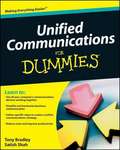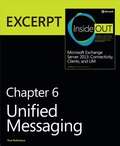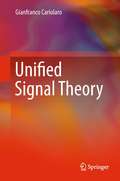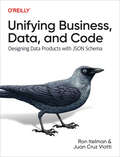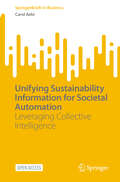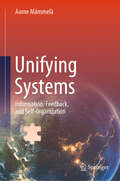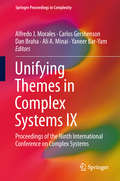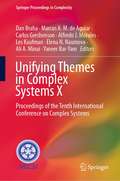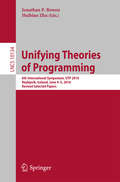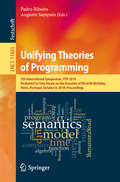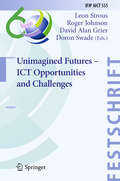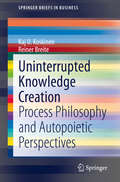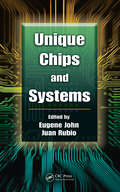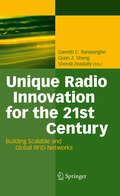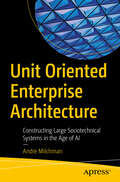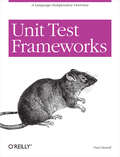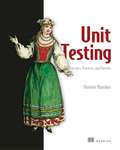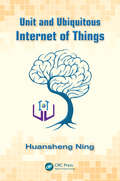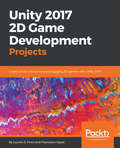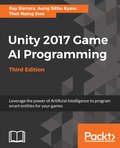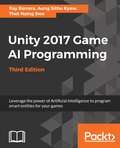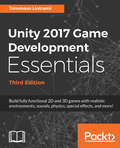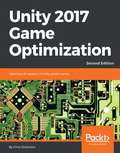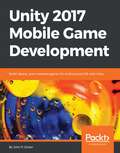- Table View
- List View
Unified Communications For Dummies
by Tony Bradley Satish ShahDiscover what Unified Communications can do for your business In our increasingly mobile world, communication must be effective, global, and available through multiple technologies seamlessly. Unified Communications logically blends and combines previously separate services and features, making communication possible by any means, with anyone, using any of your devices. This complex topic is perfect for a book dedicated to making everything easier! Unified Communications For Dummies introduces you to the many advantages this technology offers your business and shows you how to develop a strategy for bringing it about. Unified Communications is a new paradigm for working and communicating efficiently and collaboratively This book explains the features available with Unified Communications and how they can create new capabilities to drive customer satisfaction Shows how Unified Communications encompasses office and mobile phones, voicemail, instant messaging, fax, Internet phone calls, texting, and even Web conferencing Provides a step-by-step approach for creating a Unified Communications strategy Offers tips for improving the implementation process Shares real-world examples of how Unified Communications is being used today Unified Communications For Dummies shows you how to meet business needs with this emerging, cutting-edge solution.
Unified Messaging: EXCERPT from Microsoft Exchange Server 2013 Inside Out
by Paul RobichauxThis content is a direct excerpt of Chapter 7 from the book Microsoft Exchange Server 2013 Inside Out: Connectivity, Clients, & UM. This concise ebook is offered independently of the larger book for Exchange administrators seeking specific, focused information on managing Unified Messaging. Directly excerpts Chapter 7 from the book Microsoft Exchange Server 2013 Inside Out: Connectivity, Clients, & UM Offered as concise, standalone content for Exchange professionals looking for narrowly focused reference or specific problem-solving information on managing Unified Messaging and voice-related features Written by popular author Paul Robichaux, MVP for Exchange Server
Unified Signal Theory
by Gianfranco CariolaroUnified Signal Theory is an indispensible textbook dealing with the theory of deterministic signals; a topic of fundamental interest to graduates and senior undergraduates in the areas of information engineering (telecommunications, control, systems theory and electronics), astronomy, oceanography, earth science, biology and medicine. The unified theory follows an innovative approach - that of combining all signal classes into just one. The fundamental signal operations (convolution, Fourier transform, linear systems, sampling and interpolation) are established simultaneously for all the signal classes. This unified approach avoids the repetition of similar concepts consequent on other approaches' separate treatment of definitions and properties for each signal class. Modern wavelet ideas are developed in harmony with the rest of the text. Unified Signal Theory provides: * exercises and examples, to give the student practice; * solutions which are available for download and save the tutor time; and * a choice of two suggested reading paths depending on the level of the student, for an enhanced learning experience. The advantages of the unified approach are many: it permits a global vision of the topic, it is economical in teaching and learning, and it can be adjusted easily to fit new applications. This textbook presents the theory in five chapters, and goes on to demonstrate specific applications such as fast Fourier transform implementation, sampling and reconstructions of signals, and multicolor modulation systems, in a further six chapters. Mathematical concepts are introduced conceptually within the body of the book with more rigorous treatment being reserved for the appendices.
Unifying Business, Data, and Code: Designing Data Products with JSON Schema
by Ron Itelman Juan Cruz ViottiIn the modern symphony of business, each section-from the technical to the managerial-must play in harmony. Authors Ron Itelman and Juan Cruz Viotti introduce a bold methodology to synchronize your business and technical teams, transforming them into a single, high-performing unit. Misalignment between business and technical teams halts innovation. You'll learn how to transcend the root causes of project failure-the ambiguity, knowledge gaps, and blind spots that lead to wasted efforts. The unifying methodology in this book will teach you these alignment tools and more: The four facets of data products: A simple blueprint that encapsulates data and business logic helps eliminate the most common causes of wasted time and misunderstandingThe concept compass: An easy way to identify the biggest sources of misalignmentSuccess spectrums: Define the required knowledge and road map your team needs to achieve successJSON Schema: Leverage JSON and JSON Schema to technically implement the strategy at scale, including extending JSON Schema with custom keywords, understanding JSON Schema annotations, and hosting your own schema registryData hygiene: Learn how to design high-quality datasets aligned with creating real business value, and protect your organization from the most common sources of pain
Unifying Sustainability Information for Societal Automation: Leveraging Collective Intelligence (SpringerBriefs in Business)
by Carol AebiThis open access book offers a structured approach that aligns indicators of social value and provides a stable foundation amidst the dynamic and ever-changing social complexities. From detailed system scales of participation to an overview of how it works, this book presents a roadmap for automating data in systemic alignment with social value. With its adaptability to changing societal structures, it provides a pragmatic solution within existing systems while paving the way for future advancements. It is valuable for researchers and business leaders.
Unifying Systems: Information, Feedback, and Self-Organization
by Aarne MämmeläInterdisciplinary systems thinking is complementary but does not replace conventional disciplinary analytical thinking. The book is valuable for researchers, their advisors, and other thinkers interested in deep knowledge of science. Interdisciplinary systems thinking is valuable for three reasons: The goal of all science is a unified view of the world; we cannot solve the significant problems of our time without interdisciplinary collaboration; and general theories of systems and system archetypes support the solution to those problems. System archetypes are generic system models that have stood the test of time. As specialists within a discipline, we must be able to communicate between disciplines. Interdisciplinary generalists can offer us reliable visions and relevant research problems. The goal of interdisciplinary research is to find unified solutions to those problems. The book provides a lot of information from over a thousand sources in a structured manner to help the reader. The book includes a comprehensive chronology, vocabulary, and bibliography. The author has been a research professor in information engineering for over 25 years. During his career, he became interested in systems thinking, which is closely related to the philosophy and history of science.
Unifying Themes in Complex Systems IX: Proceedings of the Ninth International Conference on Complex Systems (Springer Proceedings in Complexity)
by Yaneer Bar-Yam Ali A. Minai Alfredo J. Morales Carlos Gershenson Dan BrahaUnifying Themes in Complex Systems is a well-established series of carefully edited conference proceedings that serve to document and archive the progress made regarding cross-fertilization in this field. The International Conference on Complex Systems (ICCS) creates a unique atmosphere for scientists from all fields, engineers, physicians, executives, and a host of other professionals, allowing them to explore common themes and applications of complex systems science. With this new volume, Unifying Themes in Complex Systems continues to establish common ground between the wide-ranging domains of complex systems science.
Unifying Themes in Complex Systems X: Proceedings of the Tenth International Conference on Complex Systems (Springer Proceedings in Complexity)
by Les Kaufman Yaneer Bar-Yam Ali A. Minai Alfredo J. Morales Carlos Gershenson Dan Braha Marcus A. M. de Aguiar Elena N. NaumovaThe International Conference on Complex Systems (ICCS) offers a unique interdisciplinary venue for researchers from the physical and biological sciences, social sciences, psychology and cognitive science, engineering, medicine, human systems, and global systems. This proceedings volume gathers selected papers from the conference. The New England Complex Systems Institute (NECSI) has been instrumental in the development of complex systems science and its applications. NECSI pursues research, education, knowledge dissemination, and community development efforts around the world to promote the study of complex systems and its application for the benefit of society. NECSI hosts the International Conference on Complex Systems and publishes the NECSI Book.
Unifying Theories of Programming
by Jonathan P. Bowen Huibiao ZhuThis book constitutes the refereed proceedings of the 6th International Symposium on Unifying Theories of Programming, UTP 2016, held in Reykjavik, Iceland, in June 2016, in conjunction with the 12th International Conference on Integrated Formal Methods, iFM 2016. The 8 revised full papers presented were carefully reviewed and selected from 10 submissions. They deal with the fundamental problem of combination of formal notations and theories of programming that define in various different ways many common notions, such as abstraction refinement, choice, termination, feasibility, locality, concurrency, and communication. They also show that despite many differences, such theories may be unified in a way that greatly facilitates their study and comparison.
Unifying Theories of Programming: 7th International Symposium, UTP 2019, Dedicated to Tony Hoare on the Occasion of His 85th Birthday, Porto, Portugal, October 8, 2019, Proceedings (Lecture Notes in Computer Science #11885)
by Augusto Sampaio Pedro RibeiroThis volume contains papers presented at UTP 2019, the 7th International Symposium on Unifying Theories of Programming, held in Porto, Portugal, on the 8th of October 2019. This edition of the UTP symposium is in honor of Sir Tony Hoare, on the occasion of his 85th birthday. The papers contained in this volume were invited, and friendly refereed, original contributions sought from the UTP community. One of the papers is from the distinguished invited speaker Tony Hoare himself. Nine other additional papers compose this volume, covering several aspects of Unifying Theories of Programming.
Unimagined Futures – ICT Opportunities and Challenges (IFIP Advances in Information and Communication Technology #555)
by David Alan Grier Roger Johnson Leon Strous Doron SwadeThis Festschrift, Unimagined Futures – ICT Opportunities and Challenges, is the first Festschrift in the IFIP AICT series. It examines key challenges facing the ICT community today. While addressing the contemporary challenges, the book provides the opportunity to look back to help understand the contemporary scene and identify appropriate future responses to them. Experts in different areas of the ICT scene have contributed to this IFIP 60th anniversary book, which will be a key input to the ICT community worldwide on setting policy priorities and agendas for the coming decade. In addition, a number of contributions look specifically at the role of professionals and of national, regional, and global organizations in disseminating the benefits of ICT to humanity worldwide.
Uninterrupted Knowledge Creation: Process Philosophy and Autopoietic Perspectives (SpringerBriefs in Business)
by Kaj U. Koskinen Rainer BreiteA common charge leveled against the autopoietic perspective is that it does not explain change or, consequently, knowledge creation. This book demonstrates that knowledge creation is not always an ongoing process, as is claimed in many process philosophy and autopoietic research works. The author introduces the idea of recursivity, which represents the explanatory potential for uninterrupted knowledge creation and paves the way for interaction between process (e.g. production) and stability (e.g. structure). The book describes the nature and role of recursivity in detail, especially in terms of how a system’s structure and production become media for one another. The book also acknowledges the value of the systems perspective on organizations in management studies, but suggests a different approach to defining systems, one that includes autopoietic elements.
Unique Chips and Systems (Computer Engineering Series)
by Eugene John Juan RubioWhich came first, the system or the chip? While integrated circuits enable technology for the modern information age, computing, communication, and network chips fuel it. As soon as the integration ability of modern semiconductor technology offers presents opportunities, issues in power consumption, reliability, and form-factor present challenges. The demands of emerging software applications can only be met with unique systems and chips. Drawing on contributors from academia, research, and industry, Unique Systems and Chips explores unique approaches to designing future computing and communication chips and systems.The book focuses on specialized hardware and systems as opposed to general-purpose chips and systems. It covers early conception and simulation, mid-development, application, testing, and performance. The chapter authors introduce new ideas and innovations in unique aspects of chips and system design, then go on to provide in-depth analysis of these ideas. They explore ways in which these chips and systems may be used in further designs or products, spurring innovations beyond the intended scopes of those presented. International in flavor, the book brings industrial and academic perspectives into focus by presenting the full spectrum of applications of chips and systems.
Unique Radio Innovation for the 21st Century
by Quan Z. Sheng Damith C. Ranasinghe Sherali ZeadallyAre you an engineer or a researcher developing RFID systems? Are you a manager considering deploying RFID-based applications? If so, this book is for you. Covering modern RFID systems, the challenges to RFID implementation are addressed using specific industrial research examples and common integration issues. The primary focus is on answering questions surrounding building scalable global Internet-based RFID networks. Key topics include RFID data management, RFID data processing and integration, Real-Time Locating Systems (RTLS) and sensors. The book considers the challenges of and solutions to building and exploiting global networks to guarantee one of the most important business drivers for modern RFID technology: traceability. The authors have drawn together RFID applications from the retail supply chain, asset and product lifecycle management, anti-counterfeiting and cold chain management to explore how global traceability networks can be created using RFID and sensor technologies. They present insights from world's leading research laboratories.
Unit Operations: An Approach to Videogame Criticism
by Ian BogostIn Unit Operations, Ian Bogost argues that similar principles underlie both literary theory and computation, proposing a literary-technical theory that can be used to analyze particular videogames. Moreover, this approach can be applied beyond videogames: Bogost suggests that any medium—from videogames to poetry, literature, cinema, or art—can be read as a configurative system of discrete, interlocking units of meaning, and he illustrates this method of analysis with examples from all these fields. The marriage of literary theory and information technology, he argues, will help humanists take technology more seriously and hep technologists better understand software and videogames as cultural artifacts. This approach is especially useful for the comparative analysis of digital and nondigital artifacts and allows scholars from other fields who are interested in studying videogames to avoid the esoteric isolation of "game studies." The richness of Bogost's comparative approach can be seen in his discussions of works by such philosophers and theorists as Plato, Badiou, Zizek, and McLuhan, and in his analysis of numerous videogames including Pong, Half-Life, and Star Wars Galaxies. Bogost draws on object technology and complex adaptive systems theory for his method of unit analysis, underscoring the configurative aspects of a wide variety of human processes. His extended analysis of freedom in large virtual spaces examines Grand Theft Auto 3, The Legend of Zelda, Flaubert's Madame Bovary, and Joyce's Ulysses. In Unit Operations, Bogost not only offers a new methodology for videogame criticism but argues for the possibility of real collaboration between the humanities and information technology.
Unit Oriented Enterprise Architecture: Constructing Large Sociotechnical Systems in the Age of AI
by Andre MilchmanExamine a new approach to Enterprise Architecture (EA) that challenges conventional practices and supports a transformative shift to address the demands of a rapidly evolving technological landscape. This book offers alternatives to traditional EA methods that often divide the enterprise into isolated business, application, data, and technology architectures, often resulting in disjointed operations and missed opportunities for innovation. By proposing an innovative, purpose-driven architectural style, this book emphasizes the need for a cohesive and adaptive framework that aligns all components of an enterprise with its strategic goals. Key concepts explored include the integration of social and technical elements in building large sociotechnical systems, the introduction of Unit Oriented Enterprise Architecture (UOEA) for modular and adaptable enterprise design, and the importance of Purpose Driven Design (PDD) in ensuring operational efficiency and strategic alignment. You’ll also gain insights into organizing software engineering in the cloud era, streamlining enterprise interactions, and embracing creative destruction to foster technological harmony. Unit Oriented Enterprise Architecture is your essential resource for system architects, organizational leaders, IT professionals, and students seeking to revolutionize their approach to enterprise architecture and position their organizations for success in the digital age. What You Will Learn Critically assess and dismantle outdated EA concepts to create a more adaptive and cohesive architectural framework. Explore how UOEA can enhance agility and adaptability, allowing your organization to respond more effectively to change. Organize and manage software development within cloud infrastructures, ensuring clarity, scalability, and alignment with your architectural framework. Who This Book Is For Primary Audience: Enterprise architects, organizational leaders, IT professionals; Secondary Audience: Consultants, advisors, and policymakers; Tertiary Audience: Students in system design and organizational studies, academic researchers
Unit Test Frameworks
by Paul HamillUnit test frameworks are a key element of popular development methodologies such as eXtreme Programming (XP) and Agile Development. But unit testing has moved far beyond eXtreme Programming; it is now common in many different types of application development. Unit tests help ensure low-level code correctness, reduce software development cycle time, improve developer productivity, and produce more robust software. Until now, there was little documentation available on unit testing, and most sources addressed specific frameworks and specific languages, rather than explaining the use of unit testing as a language-independent, standalone development methodology. This invaluable new book covers the theory and background of unit test frameworks, offers step-by-step instruction in basic unit test development, provides useful code examples in both Java and C++, and includes details on some of the most commonly used frameworks today from the XUnit family, including JUnit for Java, CppUnit for C++, and NUnit for .NET. Unit Test Frameworks includes clear, concise, and detailed descriptions of: The theory and design of unit test frameworks Examples of unit tests and frameworks Different types of unit tests Popular unit test frameworks And more It also includes the complete source code for CppUnit for C++, and NUnit for .NET.
Unit Testing Principles, Practices, and Patterns: Effective Testing Styles, Patterns, And Reliable Automation For Unit Testing, Mocking, And Integration Testing With Examples In C#
by Vladimir Khorikov"This book is an indispensable resource." - Greg Wright, Kainos Software Ltd. Radically improve your testing practice and software quality with new testing styles, good patterns, and reliable automation. Key Features A practical and results-driven approach to unit testing Refine your existing unit tests by implementing modern best practices Learn the four pillars of a good unit test Safely automate your testing process to save time and money Spot which tests need refactoring, and which need to be deleted entirely Purchase of the print book includes a free eBook in PDF, Kindle, and ePub formats from Manning Publications. About The Book Great testing practices maximize your project quality and delivery speed by identifying bad code early in the development process. Wrong tests will break your code, multiply bugs, and increase time and costs. You owe it to yourself—and your projects—to learn how to do excellent unit testing. Unit Testing Principles, Patterns and Practices teaches you to design and write tests that target key areas of your code including the domain model. In this clearly written guide, you learn to develop professional-quality tests and test suites and integrate testing throughout the application life cycle. As you adopt a testing mindset, you&’ll be amazed at how better tests cause you to write better code. What You Will Learn Universal guidelines to assess any unit test Testing to identify and avoid anti-patterns Refactoring tests along with the production code Using integration tests to verify the whole system This Book Is Written For For readers who know the basics of unit testing. Examples are written in C# and can easily be applied to any language. About the Author Vladimir Khorikov is an author, blogger, and Microsoft MVP. He has mentored numerous teams on the ins and outs of unit testing. Table of Contents: PART 1 THE BIGGER PICTURE 1 ¦ The goal of unit testing 2 ¦ What is a unit test? 3 ¦ The anatomy of a unit test PART 2 MAKING YOUR TESTS WORK FOR YOU 4 ¦ The four pillars of a good unit test 5 ¦ Mocks and test fragility 6 ¦ Styles of unit testing 7 ¦ Refactoring toward valuable unit tests PART 3 INTEGRATION TESTING 8 ¦ Why integration testing? 9 ¦ Mocking best practices 10 ¦ Testing the database PART 4 UNIT TESTING ANTI-PATTERNS 11 ¦ Unit testing anti-patterns
Unit and Ubiquitous Internet of Things
by Huansheng NingAlthough the Internet of Things (IoT) will play a key role in the development of next generation information, network, and communication technologies, many are still unclear about what makes IoT different from similar concepts.Answering fundamental questions about IoT architectures and models, Unit and Ubiquitous Internet of Things introduces essen
Unity 2017 2D Game Development Projects: Create three interactive and engaging 2D games with Unity 2017
by Andreas Oehlke Lauren S. FerroBuild classic arcade, shooter and platform games with Unity 2D toolset Key Features Leverage the amazing new functionalities of the latest Unity 2017 2D toolkit. Learn to create 2D characters, animations, fast and efficient game play experiences while keeping your games very lightweight Create engaging games that enable you to perform intergalactic warfare and also fun games similar to temple run and so on. Book Description 2D games are everywhere! Timeless and popular, 2D games represent a substantial segment of the games market. The Unity engine has revolutionized the gaming industry, by making it easier for game developers to create quality games on a budget. If you are looking for a guide to create 2D games using Unity 2017, look no further. With this book, you will learn all the essentials of 2D game development by creating three epic games in a step-by-step manner throughout the course of this book. The first game will have you collecting as many cakes as possible. The second will transport you to outer space to traverse as far as possible while avoiding enemy spaceships. The last game will have you running and jumping across platforms to collect coins and other exotic items. Throughout all these three games, you will create characters, make them move, and create some enemies. And then, of course, write code to destroy them!. After showing you the necessities of creating a game, this book will then help you to porting the game to a mobile platform, and provide a path to publish it on the stores. By the end of this book, you will not only have created three complete great games, but be able to apply your knowledge to create and deploy your own games. What you will learn Work with Unity 2017's new 2D workflow and create a 2D scene Set the scene with different types of backgrounds, either static or dynamically using a tileset Bring your character to life through simple animations Understand the core concepts of programming by creating basic code that controls a character and destroys an enemy Create buttons and game controls by using code snippets for input detection Develop three 2D games from genres such as classic arcade, space shooter, and platformer games Add audio and feedback and deploy your gamesWho this book is for If you are interested in creating your very own 2D games from scratch, then this book will give you all the tools you need to succeed. No C# knowledge is required, all you need is basic coding and scripting knowledge. Whether you are completely new to Unity or have used Unity before and would like to learn about the new 2D features of Unity, this book is for you.
Unity 2017 Game AI Programming, Third Edition: Leverage the power of Artificial Intelligence to program smart entities for your games, 3rd Edition
by Raymundo Barrera Davide AversaUse Unity 2017 to create fun and unbelievable AI entities in your games with A*, Fuzzy logic and NavMesh Key Features Explore the brand-new Unity 2017 features that makes implementing Artificial Intelligence in your game easier than ever Use fuzzy logic concepts in your AI decision-making to make your characters more engaging Build exciting and richer games by mastering advanced Artificial Intelligence concepts such as Neural Networks Book Description Unity 2017 provides game and app developers with a variety of tools to implement Artificial Intelligence. Leveraging these tools via Unity's API or built-in features allows limitless possibilities when it comes to creating your game's worlds and characters. This third edition with Unity will help you break down Artificial Intelligence into simple concepts to give you a fundamental understanding of the topic to build upon. Using a variety of examples, the book then takes those concepts and walks you through actual implementations designed to highlight key concepts, and features related to game AI in Unity 5. Further on you will learn to distinguish the state machine pattern and implement one of your own. This is followed by learning how to implement a basic sensory system for your AI agent and coupling it with a Finite State Machine (FSM). Next you'll learn how to use Unity's built-in NavMesh feature and implement your own A* pathfinding system. You will then learn how to implement simple flocks and crowd's dynamics, key AI concepts. Moving on, you will learn how to implement a behavior tree through a game-focused example. Lastly, you'll combine fuzzy logic concepts with state machines and apply all the concepts in the book to build a simple tank game. What you will learn Understand the basic terminology and concepts in game AI Explore advanced AI Concepts such as Neural Networks Implement a basic finite state machine using state machine behaviors in Unity 2017 Create sensory systems for your AI and couple it with a Finite State Machine Wok with Unity 2017's built-in NavMesh features in your game Build believable and highly-efficient artificial flocks and crowds Create a basic behavior tree to drive a character's actions Who this book is for This book is intended for Unity developers with a basic understanding of C# and the Unity editor. Whether you're looking to build your first game or are looking to expand your knowledge as a game programmer, you will find plenty of exciting information and examples of game AI in terms of concepts and implementation.
Unity 2017 Game AI Programming, Third Edition: Leverage The Power Of Artificial Intelligence To Program Smart Entities For Your Games
by Ray BarreraWhether you are developing traditional, serious, educational, or any other kind of game, understanding how to apply artificial intelligence can take the fun-factor to the next level! This book will not only uncover the newly released features in Unity 2017 but also teach you how to implement it in your game. Moreover, you will be working with different AI concepts and will help you to use it in your game to make it more awesome.
Unity 2017 Game Development Essentials, Third Edition: Build fully functional 2D and 3D games with realistic environments, sounds, physics, special effects, and more!
by Will Goldstone Tommaso LintramiGo through 3D game development techniques using Unity Key Features Kick-start your game development carrer and build ready-to-play 2D and 3D games with ease Understand the key concepts in game design including scripting, physics, instantiation, particle effects, and more Build games that run on desktop, mobile, and the web Book Description Unity is the most popular game engine among Indie developers, start-ups, and medium to large independent game development companies. This book is a complete exercise in game development covering environments, physics, sound, particles, and much more—to get you up and running with Unity rapidly. In this informal guide, you’ll get to grips with the basics of game development, starting off with using C# for scripting. You'll get the hang of Unity's development environment and will be able to set up the required assets for your frst 2D game. You'll work on animating your player and getting it to move in the 2D environment. Next, you'll see how to build the game in 3D, making use of Unity's new 3D animation system. After building a beautiful 3D environment for the game, you’ll work with the latest physics system that Unity has to offer and will make your assets interactive. You'll induce artifcial intelligence into the enemies and develop a mechanism to hit them with rocks and punches. Once you've made things pretty with the particle system, you'll move on to optimize the game, adding a cross-platform ready UI, and publishing your game across multiple platforms. You'll walk away with a cool 2D parallax side parallax game and an even cooler third-person 3D adventure game, but most importantly, with the confdence to build your own games. What you will learn Script games using C# Build your very first 2D and 3D games Work through the key concepts in game development such as animations, physics, and scripting Test and optimize your games to attain great performance Create fully functional menus, HUDs, and UI Create player character interactions with AI and NPC Who this book is for Who this book is written for: If you're a designer or animator who wishes to take their first steps into game development or prototyping, or if you've simply spent many hours sitting in front of video games with ideas bubbling away in the back of your mind, Unity and this book should be your starting point.
Unity 2017 Game Optimization - Second Edition
by Chris DickinsonMaster a series of performance-enhancing coding techniques and methods that help them improve the performance of their Unity3D applications About This Book • Discover features and techniques to optimize Unity Engine's CPU cycles, memory usage, and the GPU throughput of any application • Explore multiple techniques to solve performance issues with your VR projects • Learn the best practices for project organization to save time through an improved workflow Who This Book Is For This book is intended for intermediate and advanced Unity developers who have experience with most of Unity's feature-set, and who want to maximize the performance of their game. Familiarity with the C# language will be needed. What You Will Learn • Use the Unity Profiler to find bottlenecks anywhere in your application, and discover how to resolve them • Implement best practices for C# scripting to avoid common pitfalls • Develop a solid understanding of the rendering pipeline, and maximize its performance by reducing draw calls and avoiding fill rate bottlenecks • Enhance shaders in a way that is accessible to most developers, optimizing them through subtle yet effective performance tweaks • Keep your scenes as dynamic as possible by making the most of the Physics engine • Organize, filter, and compress your art assets to maximize performance while maintaining high quality • Discover different kinds of performance problems that are critical for VR projects and how to tackle them • Use the Mono Framework and C# to implement low-level enhancements that maximize memory usage and avoid garbage collection • Get to know the best practices for project organization to save time through an improved workflow In Detail Unity is an awesome game development engine. Through its massive feature-set and ease-of-use, Unity helps put some of the best processing and rendering technology in the hands of hobbyists and professionals alike. This book shows you how to make your games fly with the recent version of Unity 2017, and demonstrates that high performance does not need to be limited to games with the biggest teams and budgets. Since nothing turns gamers away from a game faster than a poor user-experience, the book starts by explaining how to use the Unity Profiler to detect problems. You will learn how to use stopwatches, timers and logging methods to diagnose the problem. You will then explore techniques to improve performance through better programming practices. Moving on, you will then learn about Unity's built-in batching processes; when they can be used to improve performance, and their limitations. Next, you will import your art assets using minimal space, CPU and memory at runtime, and discover some underused features and approaches for managing asset data. You will also improve graphics, particle system and shader performance with a series of tips and tricks to make the most of GPU parallel processing. You will then delve into the fundamental layers of the Unity3D engine to discuss some issues that may be difficult to understand without a strong knowledge of its inner-workings. The book also introduces you to the critical performance problems for VR projects and how to tackle them. By the end of the book, you will have learned to improve the development workflow by properly organizing assets and ways to instantiate assets as quickly and waste-free as possible via object pooling. Style and approach This practical book will help readers understand the essentials of the Unity3D engine and how to build games while improving the performance of their applications.
Unity 2017 Mobile Game Development
by John P. DoranLearn to create, publish and monetize your mobile games with the latest Unity 2017 tool-set easily for Android and iOS About This Book • One-stop solution to becoming proficient in mobile game development using Unity 2017 • Port your Unity games to popular platforms such as iOS and Android • Unleash the power of C# scripting to create realistic gameplay and animations in Unity 2017. Who This Book Is For If you are a game developer and want to build mobile games for iOS and Android, then this is the book for you. Previous knowledge of C# and Unity is helpful, but not required. What You Will Learn • Use Unity to build an endless runner game • Set up and deploy a project to a mobile device • Create interesting gameplay elements using inputs from your mobile device • Monetize your game projects with Unity ads and in-app purchases • Design UI elements that can be used well in Landscape and Portrait mode at different resolutions, supporting phones, tablets, and PCs. • How to submit your game to the iOS and Android app stores In Detail Unity has established itself as an overpowering force for developing mobile games. If you love mobile games and want to learn how to make them but have no idea where to begin, then this book is just what you need. This book takes a clear, step-by-step approach to building an endless runner game using Unity with plenty of examples on how to create a game that is uniquely your own. Starting from scratch, you will build, set up, and deploy a simple game to a mobile device. You will learn to add touch gestures and design UI elements that can be used in both landscape and portrait mode at different resolutions. You will explore the best ways to monetize your game projects using Unity Ads and in-app purchases before you share your game information on social networks. Next, using Unity's analytics tools you will be able to make your game better by gaining insights into how players like and use your game. Finally, you'll learn how to publish your game on the iOS and Android App Stores for the world to see and play along. Style and approach This book takes a clear, step-by-step approach for Unity game developers to explore everything needed to develop mobile games with Unity.
